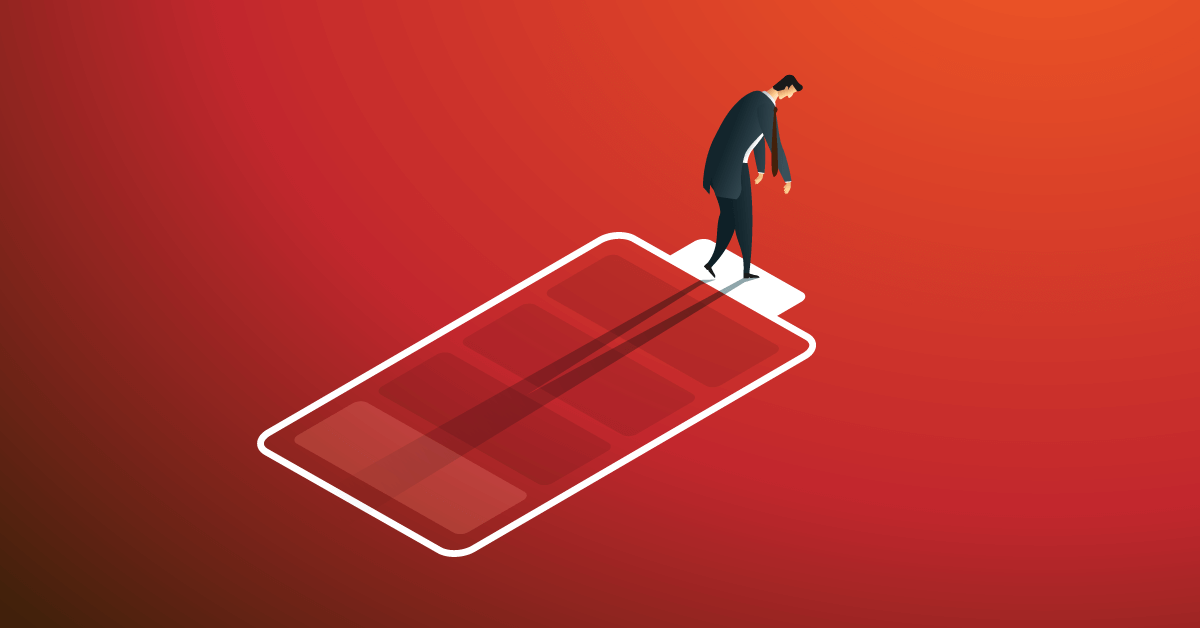It’s important to recognize that you’re not exempt from those worries either, though. It’s time to talk about HR burnout.
HR professionals have been dealing with constant change over the last two years. If you’re feeling more stressed than ever, you’re not alone. In a recent survey conducted by Human Resource Executive, 86% of HR employees said their stress increased in the last year. And 44% say their levels of stress rose “dramatically.”
HR professionals are usually tasked with creating a healthy workplace for the rest of the company. Taking care of your own wellbeing is part of that.
In this article, we’ll talk about how to recognize the signs of burnout in yourself. We’ll also discuss the reasons HR burnout is especially prominent right now and give you some tips on how to battle burnout.
The signs of burnout
Burnout occurs when excessive anxiety leads to mental, emotional, and physical stress. Some stress is inevitable in a position that involves caring for everyone else.
The danger comes when stress is prolonged and starts to affect your work and your health. Here are some of the signs that what you’re experiencing is more than the daily demands of the job:
- Lost motivation. Most people are in this job because they have a passion for helping others. If you find yourself feeling disinterested or disconnected from what you’re doing, it’s a sign that something’s wrong. Overwork and anxiety often leave little energy for anything else. Burnout often shows up as a lack of interest in work or hobbies that were previously fulfilling.
- Mental fatigue. You experience “brain fog,” muddled thinking, or difficulty making decisions. Burnout creates a drain on your mental energy. If you feel like you’re slogging through your daily routine struggling to keep your focus, there’s a problem that needs to be solved.
- Feelings of negativity or helplessness. When you’re overworked and exhausted, it can be hard to stay positive. You may find yourself increasingly focused on what’s wrong at work, with your colleagues, with your boss, or how work is being done. You may be more irritable or feel hopeless that your work situation will never improve. There’s cause for concern when these feelings persist beyond just a bad day or an off week.
- Poor physical health. There’s a strong connection between mental or emotional wellbeing and your physical health. Burnout can interfere with sleep by keeping you up at night worrying. It can hurt energy levels by leaving little time or motivation for your regular fitness routines. It can also affect your immune system, leaving you more prone to illness that takes you away from work. Dramatic and persistent changes to your regular health can be a warning sign to watch out for.
Why we need to talk about HR burnout
The pandemic has created an almost non-stop barrage of additional work for HR. And it’s creating higher rates of stress. The one constant has been change, as workers have had to keep up with:
- new policies and practices around remote work
- continually shifting health regulations and mandates
- return to office plans
Not to mention finding ways to alleviate the general pandemic stress everyone feels. Add to that the pressures of retaining employees during “The Great Resignation,” and it’s not hard to see why people are getting burned out.
So what do you do about it?

Fighting HR burnout
Once you recognize the signs of burnout, you need to take action. You would never ignore something that affected another employee’s ability to perform their job or feel safe at work. Treat yourself with the same care and learn to counter the stress that’s affecting you.
Here are five tips for countering burnout or preventing it in the first place.
1. Set boundaries
Working remotely can disrupt the work-life balance. It’s easy to blur the lines between work and home when it’s all the same, and it doesn’t take long before work concerns and emails are creeping into your personal time and weekends.
Feeling pressure to be available at all hours is a fast formula for burnout. Set boundaries to protect your personal time and give yourself a chance to renew mentally and physically.
Determine what hours you’ll be available and stick to them. Even if your desk is in your home, create a sense of separation by stepping away from it at the end of the day. Acknowledge that not all requests are immediate emergencies, and let them wait till the next day.
2. Learn skills for self-care and managing stress
Managing stress and finding work-life balance are skills that can be taught. For you, and your colleagues’ benefit, make these skills a part of your employee training strategy.
Offer programs in self-care and mindfulness to learn to decompress and reduce anxiety. Consider including courses on remote work skills like time and project management. They’ll help you organize your work schedule and keep it from getting overwhelming.
3. Lighten your admin load
While necessity made your workload bigger during the early days of the pandemic, you don’t need to continue to carry all that weight going forward. Find ways to automate administrative tasks where possible.
For instance, from the start, you (or your department) were probably single-handedly responsible for learning, communicating, and enforcing new work policies. As your company settles into the new normal of work, it’s time to think about how you can offload some of the responsibility.
Now that policies are settling into “how we’ll do things going forward,” make such resources accessible for all. Create a handbook (or update existing documents) to include these policies. Consider adding an FAQs section so people can search for solutions before bringing everything to you to handle.
Post this material online or on an internal server everyone can access. And then all you have to do is make sure the information is up to date.
4. Ask for help
Get your team involved by training them on some of the tasks that are overwhelming you. For example, bring them up to speed on interview procedures so they can pitch in with new hires or exit interviews.
You can also reach out to other teams or management for help. Ask operations to identify inefficiencies or obstacles that may be contributing to your workload. And let your manager know how you’re feeling so they can be supportive of changes you make or provide you the resources you need.
5. Practice healthy habits
Taking care of your physical and mental wellbeing can seem difficult when you’re swamped with work. But taking time to practice good health will be a huge help in controlling those feelings of anxiety or helplessness.
Set goals to get good sleep each night. Avoid binging on unhealthy junk food and plan to have healthy snacks on hand to keep your body fueled and your mind clear. And make exercising a priority if it’s something that’s part of your normal life. Even a quick walk outside can help you clear your head and process stress better.
Take care of yourself so you can be there for your employees
Because your role involves serving others, it may be easy to forget to check in with yourself and extend the same level of care. But recognizing and addressing burnout now will help you renew your energy for doing what you love.
When you’re healthy and enjoy your job, it’ll be easier for you to help others reach that point, too. Take the time to address your own burnout so you can find the passion that brought you to this job in the first place.



